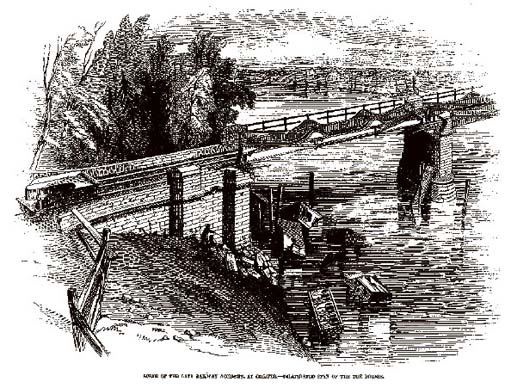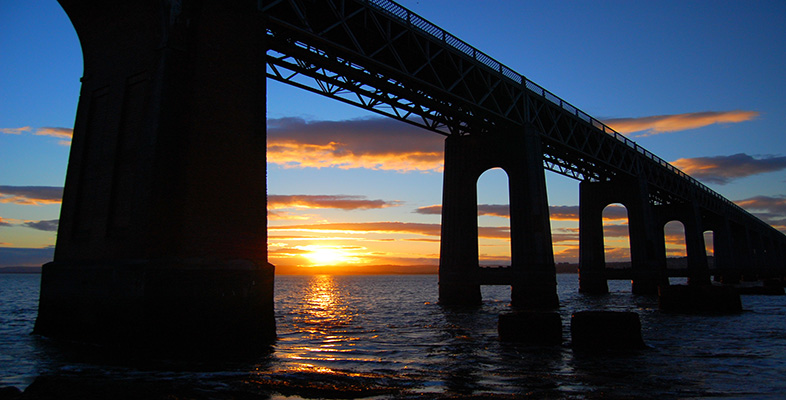2.4 Early disasters
Many of the earliest bridges were simply a wooden trestle type of construction, an efficient and easy-to-build structure, yet providing a secure and safe passage for heavy metal trains. Although we tend to associate such structures with the United States, they were in fact widely used in Britain in the early days of steam locomotion. However, they had a limited lifetime owing to rot, so were gradually replaced by wrought iron girder bridges, often laid on brick or masonry piers.
Designers frequently used cast-iron as a cheap alternative to wrought iron, especially as it had been proved in the bridge at Coalbrookdale. However, lack of consideration of the brittle nature of the material led to one spectacular disaster in 1847. A long bridge over the river Dee at Chester failed suddenly while a passenger train was crossing – the result is shown in Figure 8. The investigation is discussed in more detail in Input 6, linked below. Although the subsequent inquest cleared the famous engineer Robert Stephenson, he turned to wrought iron alone for his future bridges over the Conway and Menai Straits, and tested his materials with greater rigour than before.

Click 'View document' below to open Input 6
View document [Tip: hold Ctrl and click a link to open it in a new tab. (Hide tip)]
Collisions were frequent on the early railway system, mainly because of the lack of control of trains and what track they were on in the system. Failures attributable to engineering faults included numerous boiler explosions – largely caused by galvanic corrosion – and wheel or axle fractures (Table 3). A similar pattern of disasters occurred in the fast-growing rail networks in both Europe and North America.
A defining moment for the British railway system occurred some 32 years later, when the bridge over the river Tay – the world's longest bridge – collapsed in a gale while carrying a passenger train from Edinburgh.
| Date | Place | Railway | Description |
|---|---|---|---|
| 1830, 15 Sept | Rainhill | L & M | Mr Huskisson run down |
| 1840, 7 Aug | Howden | H & S | casting fell from truck |
| 1840, 10 Nov | Bromsgrove | B & G | boiler explosion |
| 1846, 1 Jan | Tonbridge | SE | bridge collapsed |
| 1847, 24 May | Dee Bridge | C & H | bridge collapsed |
| Southall | GW | broken wheel tyre, goods derailed | |
| 1849, 27 June | Hemerdon | SD (GW) | boiler explosion |
| 1850 | Wolverton | L & B | boiler explosion |
| 1860, 20 Feb | Tottenham | EC | derailment, broken tyre |
| 1861, 8 July | Easenhall | LNW | boiler explosion, Irish mail |
| 1862, 8 Nov | Westbourne Park | GW | boiler explosion |
| 1864, 5 May | Colne | Mid | boiler explosion |
| 1864, 9 May | Bishop's Road | GN | boiler explosion |
| Leominster | S & H | boiler explosion | |
| 1870, 20 June | Newark | GN | collision, broken wagon axle |
| 1870, 26 Dec | Hatfield | GN | derailment, broken coach tyre |
| 1873, 3 Aug | Wigan | LNW | high-speed derailment on points |
| 1874, 24 Dec | Shipton-on-Cherwell | GW | derailment from broken coach tyre |
| 1879, 28 Dec | Tay Bridge | NB | bridge collapsed in gale |
